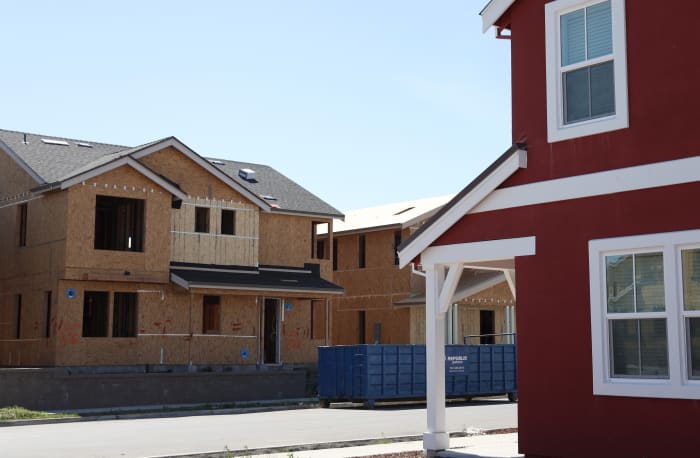House prices have been ballistic over the last two years, in part due to a big shortage in housing materials. A new report lays out what elements actually go into building a home, highlighting how complicated — and expensive — the process can get.
“In the last three years, the cost to build a home in the U.S. has risen at an unprecedented rate,” wrote the authors of Bank of America’s 2022 “Who builds the house ” report, released June 8.
A key driver of higher home prices is the shortage in building materials.
“The way home builders describe the supply chain right now is whack-a-mole,” Rafe Jadrosich, an analyst at Bank of America and a co-author of the report, told MarketWatch, “where every time they find one thing that they fix, another one pops up … there’s always a new category that’s creating the bottleneck.”

Bank of America estimated the value of the raw materials in an average single-family home in America to be around $ 118,000 in 2021. Labor and land costs -– which can vary by region –- constitute the remaining two-thirds of the cost of a home.
Photo by Justin Sullivan/Getty Images
The bill for materials required to build an average size new single-family home increased by 42% from 2018 to 2021 -– making materials cost roughly $ 35,000 more.
Bank of America estimated the value of the raw materials in an average single-family home in America to be around $ 118,000 in 2021. Labor and land costs -– which can vary by region –- constitute the remaining two-thirds of the cost of a home, Jadrosich added.
“Home construction cost has consistently outpaced overall inflation over the last 40 years,” the report added.
Rising inflation in the U.S. is also contributing to an increase in prices of “household furnishings and operations,” a broad category that includes window and floor coverings and moving and freight expenses, among other items, according to the Bureau of Labor Statistics.
The index for household furnishings and operations rose by 0.4% over the month of May as compared to the previous month, and was up 8.9% from last year.
The Bank of America report, which factored in data from the National Association of Home Builders, detailed 14 components that go into building a house and how much they cost on average:
What materials go into building a home?
- Framing lumber/engineered wood
This category accounted for the largest percentage of all material in a home, at 30.2%. The cost of lumber content per home was around $ 35,488. Lumber prices have been on a wild ride over the last year. The commodity has come off all-time highs in 2021, when lumber prices had nearly tripled, particularly over the last four months of the year. That meant an increase of $ 18,600 in costs to an average new single-family home.
But experts are expecting demand to soften amid a slowdown in U.S. home sales.
“A significant factor in the price of lumber is the price of timber (the sawn tree),” the Bank of America report stated. The South “continues to be amply supplied in timber at present,” it added, “as standing inventory remains higher than post-Great Financial Crisis levels.”
- Concrete (foundation)
This category accounted for 8.9% of all content in a home, but was costly, at around $ 10,526.
- Windows and doors
Windows and doors have had a notorious reputation among builders over the last year, with many companies scrambling to find them.
While they only make up 8.9% of the total material per home, they are, like concrete, costly, at $ 10,519. Bank of America noted that windows and doors tend to be a labor intensive industry.
A shortage of windows has slowed down the construction process considerably, Jadrosich said. “You can’t finish a lot of the houses if you don’t have the windows in,” he explained. “You can’t put your appliances in, and paint the walls, and finish your floors, if the house isn’t sealed with windows.”
And until that supply chain for windows improves, “you’re gonna have a pretty slow, elongated build cycle for a lot of the home builders,” he added.
And with a shortage in specific items like windows, “it’s really difficult to live in the house if you don’t have them,” Jadrosich said. “Things like appliances, it’s hard to move in, or even get an appraisal until those are in the house. It can really, really slow down the process.”
- Siding
- Plumbing
Plumbing has been one of the sectors that has been hardest hit by the labor shortage, Bank of America said. “Employee retention will be critical to keep up with the rising demand,” they said.
- Cabinets
- HVAC
- Roofing
- Flooring
- Structural panels
- Wallboard/drywall
- Appliances
- Architectural coatings
- Fiberglass insulation
- Other
Let’s also not forget the various sub-sectors within homebuilding –- from flooring to paints.
And U.S. households may be facing an unseen cost as a result of rising prices in homebuilding: The average home in the U.S. has shrunk considerably over the years.
Bank of America noted that from 1982 to 2017, the average square footage of a home has declined eight times on a year-over-year basis, three of which was during and immediately after the global financial crisis.
The median square footage for a single-family home is now around 2,338 feet, according to fourth quarter data from the NAHB.
Got thoughts on the housing market? Write to MarketWatch reporter Aarthi Swaminathan at aarthi@marketwatch.com.
